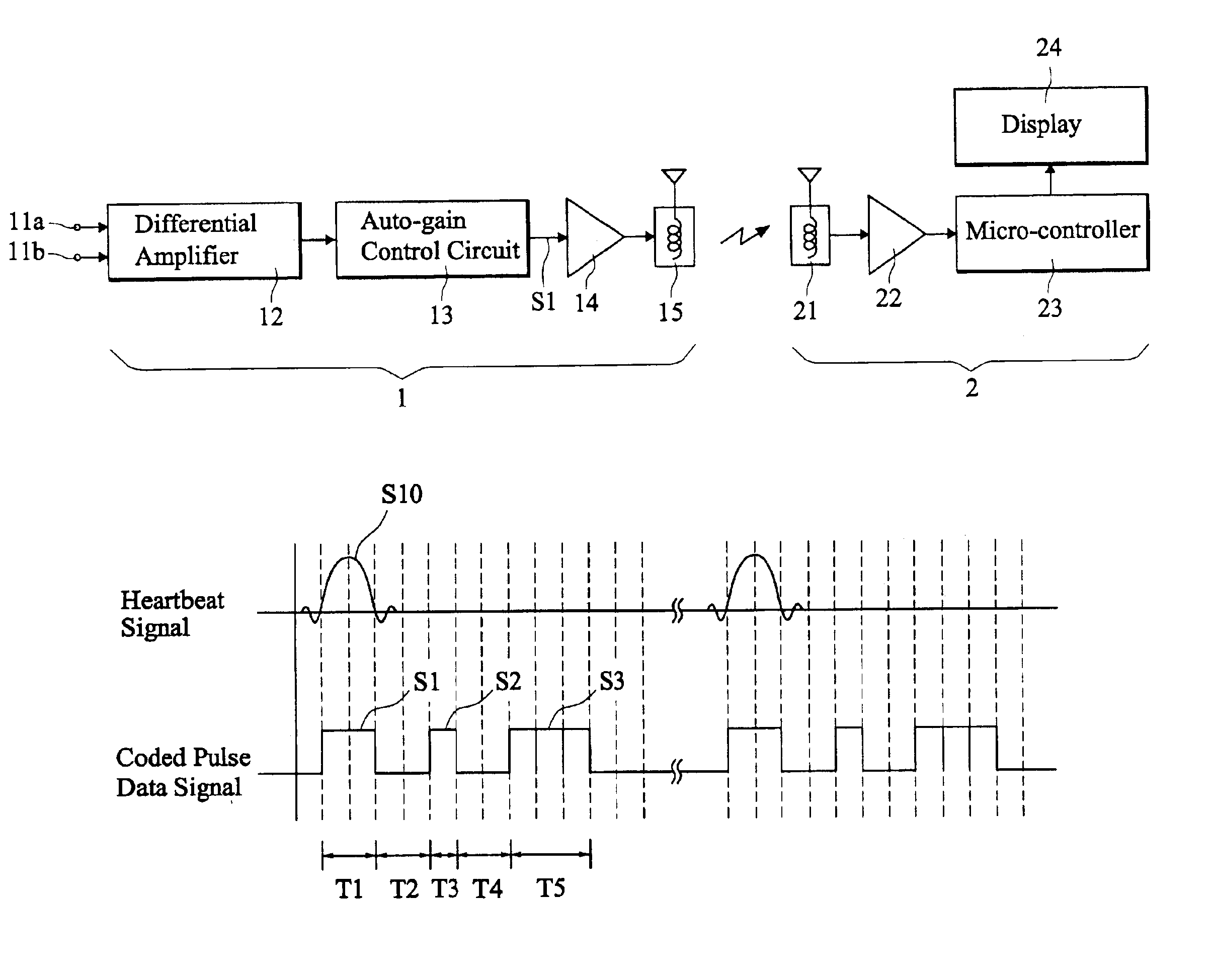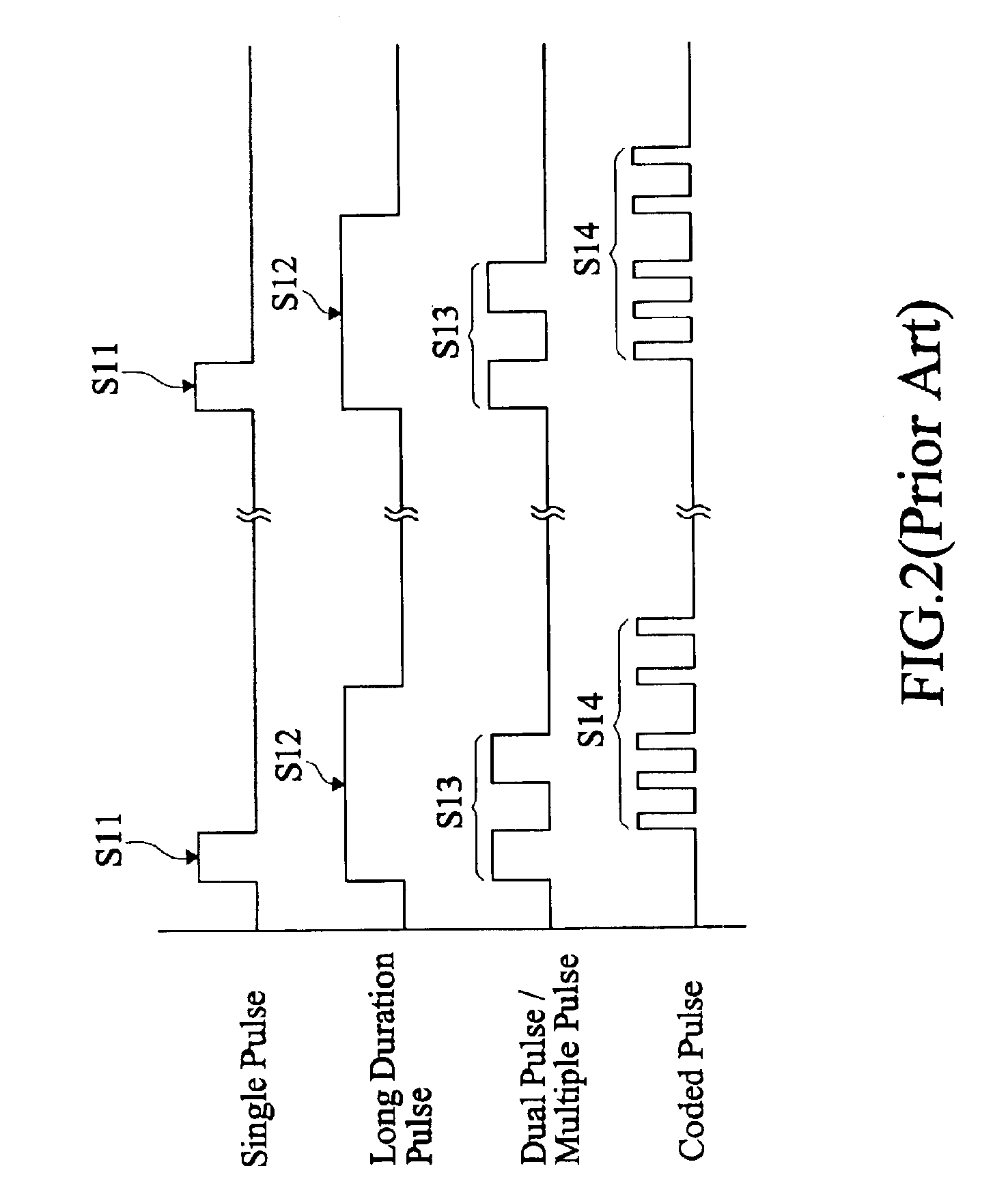Pulse data coding method for wireless signal transmitting and receiving devices
- Summary
- Abstract
- Description
- Claims
- Application Information
AI Technical Summary
Benefits of technology
Problems solved by technology
Method used
Image
Examples
first embodiment
[0030]The check code pulse signal S3 is obtained by coding the pulse data signal S1 and the identification code pulse signal S2 in accordance with a predetermined coding process or coding protocol. The coding process may be, for example, an algorithm of addition (+), subtraction (−), multiplication (×), division (÷), or a ratio operation of the pulse data signal S1 and the identification code pulse signal S2. For instance, when the coding process for the check code pulse signal S3 is an algorithm of addition operation (+) in accordance with the present invention, then the time data for the coded pulse data signal of the heartbeat signal S10 are as follows:[0031]T1=10 ms[0032]T2=10 ms[0033]T3=5 ms[0034]T4=10 ms[0035]T5=T1+T3=10 ms+5 ms=15 ms.
[0036]In this embodiment, the check code pulse signal S3 has a pulse width T5 of 15 ms. Thus, the signal transmitted by the transmitter 1 and received at the receiver 2 end would be as follows:[0037]T1=10 ms[0038]T2=10 ms[0039]T3=5 ms[0040]T4=10 ...
second embodiment
[0043]Alternatively, based on the algorithm of addition operation (+), the check code pulse signal S3 may be obtained by extendedly coding the pulse duration T1 of the pulse data signal S1, the time interval T2, the pulse duration T3 of the identification code pulse signal S2, and the time interval T4 in accordance with the present invention. With reference to FIG. 6, in this embodiment, the time data for the coded pulse data signal of the heartbeat signal S10 are as follows:[0044]T1=10 ms[0045]T2=10 ms[0046]T3=5 ms[0047]T4=10 ms[0048]T5=T1+T3=10 ms+5 ms=15 ms[0049]T6=T2+T4=10 ms+10 ms=20 ms
[0050]That is, the pulse data coding processes of this embodiment comprises steps of summing the first pulse duration T1 of the pulse data signal S1 and the second duration T3 of the identification code pulse signal S2 to obtain a high state pulse width T5 of the check code pulse signal S3, and summing the first time interval T2 and the second time interval T4 to obtain a low state pulse width T6...
third embodiment
[0058]Please refer to FIG. 7. When, for example, the coding process for the check code pulse signal S3 is an algorithm of subtraction operation (−) in accordance with the present invention, then the time data for the coded pulse data signal of the heartbeat signal S10 are as follows:[0059]T1=10 ms[0060]T2=15 ms[0061]T3=5 ms[0062]T4=10 ms[0063]T5=T1−T3=10 ms−5 ms=5 ms
[0064]In this embodiment, the check code pulse signal S3 has a pulse width T5 of 5 ms. Thus, the signal transmitted by the transmitter 1 and received at the receiver 2 end would be as follows:[0065]T1=10 ms[0066]T2=15 ms[0067]T3=5 ms[0068]T4=10 ms[0069]T5=5 ms
[0070]Similarly, the receiver 2, on receipt of the coded pulse data signal transmitted by the transmitter 1, would check the check code pulse signal S3 of the received signal according to the predetermined coding process to determine whether the received signal is a correct signal.
PUM
 Login to view more
Login to view more Abstract
Description
Claims
Application Information
 Login to view more
Login to view more - R&D Engineer
- R&D Manager
- IP Professional
- Industry Leading Data Capabilities
- Powerful AI technology
- Patent DNA Extraction
Browse by: Latest US Patents, China's latest patents, Technical Efficacy Thesaurus, Application Domain, Technology Topic.
© 2024 PatSnap. All rights reserved.Legal|Privacy policy|Modern Slavery Act Transparency Statement|Sitemap



